Time:2025-07-17
The Timeless Appeal of Retro Neon in Diner Aesthetics
In the competitive landscape of restaurant design, retro neon diner signs have emerged as a powerful tool for creating immersive, nostalgic experiences that resonate with diners of all ages. These iconic signs—with their bold colors, classic typography, and warm, diffused glow—evoke the golden era of mid-20th-century diners, where chrome counters, checkered floors, and jukeboxes defined a culture of casual, communal eating. Today, restaurants leverage retro neon not just as decor, but as a storytelling device, blending vintage charm with contemporary functionality to create memorable spaces. From retro-themed diners to modern eateries seeking to infuse character, these signs bridge the past and present, enhancing brand identity and encouraging social sharing. This article explores the design principles, technical considerations, and strategic applications of retro neon diner signs, offering a comprehensive guide for restaurateurs, interior designers, and nostalgia enthusiasts.
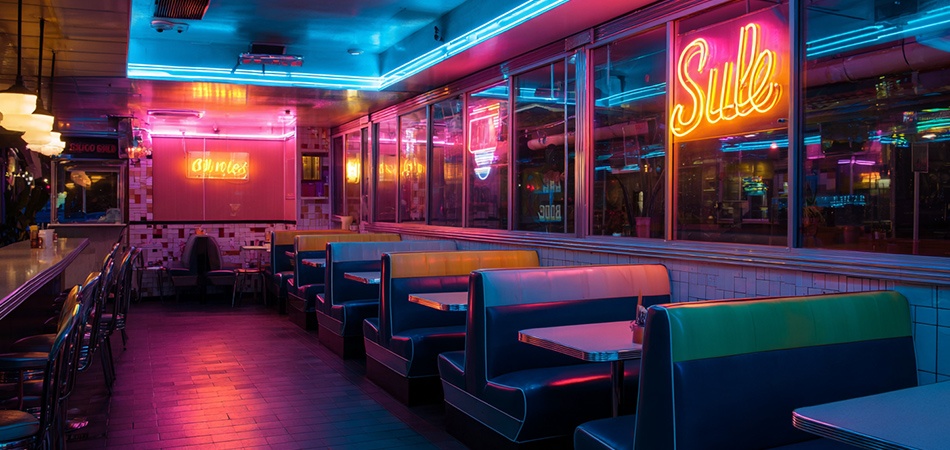
Design Principles: Capturing the Essence of Mid-Century Diner Culture
Typography: Bold, Unapologetic, and Instantly Recognizable
Classic Fonts That Define the Era:
Script Fonts: Cursive styles with sweeping curves (e.g., Brush Script, Pacifico) evoke the hand-painted signage of 1950s diners, perfect for 招牌 (signs) spelling “DINER” or “OPEN” above entryways.
Block Letters: Thick, sans-serif fonts (e.g., Impact, Arial Black) with rounded edges, often outlined in a contrasting color, dominate menu boards and wall murals. These fonts shout “BURGERS” or “MILKSHAKES” with the same energy as vintage drive-in signs.
Retro Logos: Custom designs incorporating diner icons—coffee cups, hamburgers, jukeboxes, or vintage cars—blended with text to reinforce thematic consistency.
Color Palettes: Vibrancy Rooted in Nostalgia
Primary Color Schemes:
Red and White: The quintessential diner pairing, with red neon (traditional glass or LED) symbolizing energy and urgency, paired with white for clarity—ideal for “24 HOURS” or “SPECIALS” signs.
Blue and Yellow: Soft blue neon for a calming backdrop, accented with bright yellow for highlights, evoking retro soda fountains and ice cream parlors.
Pastel Accents: Muted pinks, mint greens, or baby blues for a 1950s soda shop vibe, often used in smaller signs for “COUNTER” or “BOOTHS” to guide seating.
Scale and Placement: Balancing Nostalgia with Function
Statement Entrance Signs: Oversized neon letters spelling “DINER” or the restaurant’s name, mounted above doorways or on exterior walls, framed by chrome trim to mimic vintage storefronts.
Countertop and Bar Accents: Miniature neon signs (e.g., “COFFEE” or “PIE”) mounted above service counters, casting warm light on Formica surfaces and stainless steel fixtures.
Wall Murals and Backdrops: Large-scale neon installations depicting retro scenes— Route 66, classic cars, or diner staff—paired with vintage posters to create immersive photo backdrops, driving social media engagement.
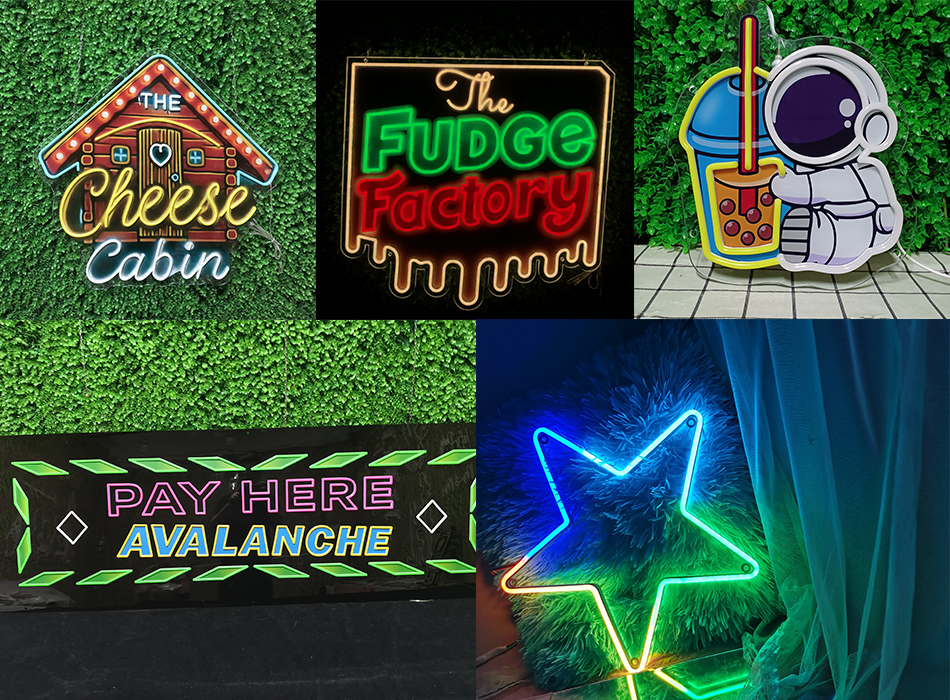
Technical Foundations: Balancing Authenticity and Durability
Traditional Glass Neon: The Gold Standard for Nostalgia
Artisanal Craftsmanship: Hand-bent borosilicate glass tubes filled with neon (for red) or argon (for blue/green), creating the soft, flickering glow that defines retro aesthetics. Skilled neon benders replicate classic fonts, ensuring curves and angles match 1950s originals.
Warmth and Character: The slight imperfection in glass neon—subtle variations in brightness, gentle hum, and gradual warm-up—adds authenticity, making it ideal for high-end retro diners aiming for historical accuracy.
Considerations: Fragile and requiring high-voltage transformers, glass neon demands careful installation (avoiding high-traffic areas) and periodic maintenance (re-gassing, tube replacement) to preserve its vintage appeal.
LED Neon Flex: Modern Durability with Retro Charm
Vintage-Inspired Design: LED neon flex mimics glass neon’s glow using surface-mounted LEDs encased in flexible silicone, available in retro colorways (e.g., “classic red,” “soda fountain blue”). Its bendability allows for precise replication of 1950s fonts and motifs.
Practical Advantages for Restaurants: Shatterproof, low-voltage (12V/24V), and energy-efficient, LED neon flex suits busy diner environments. It withstands frequent cleaning, accidental bumps, and humidity—critical for kitchens and dining areas.
Customization: RGB capabilities let restaurants switch between retro color schemes for themed nights (e.g., 50s sock hops, 60s mod nights) while maintaining a vintage base design.
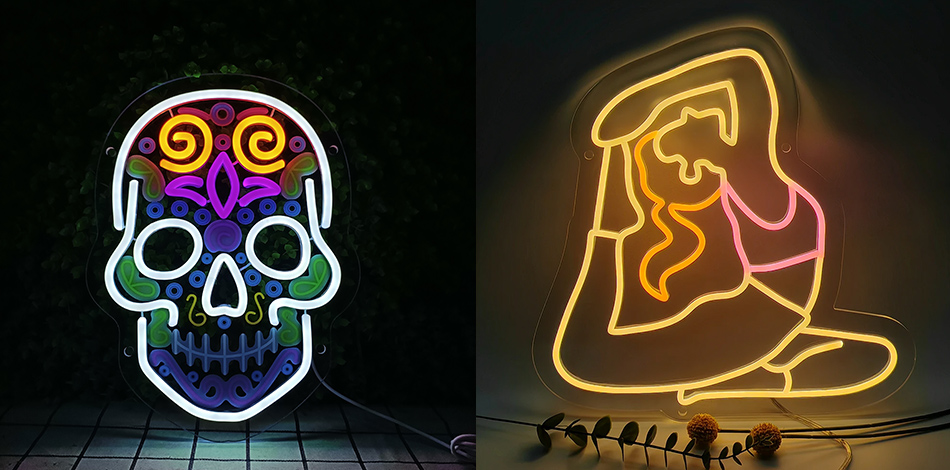
Strategic Applications in Restaurant Zones
Entry and Waiting Areas: Setting the Retro Tone
Exterior-Interior Transition: A “WELCOME” sign in red glass neon above the entrance, paired with a backlit menu board featuring retro typography, immediately signals the diner’s theme. LED neon versions work well here for durability against weather or heavy foot traffic.
Host Stand Accents: A small neon sign spelling “WAITING” or the restaurant’s nickname (e.g., “MABEL’S”) on the host podium, surrounded by vintage memorabilia like metal lunch boxes or vinyl records, reinforcing the nostalgic narrative.
Dining Counters and Booths: Intimate Retro Glow
Counter Backsplashes: Neon strips outlining the edge of Formica counters, casting warm light on stools and dinerware. A “COUNTER SERVICE” sign in yellow neon directs guests, while small “HOT” signs highlight coffee stations.
Booth Dividers: Neon “PRIVATE” signs or retro icons (e.g., milkshake glasses) mounted on booth partitions, creating cozy, Instagram-worthy nooks. LED neon flex is preferred here for its durability against leaning elbows and food splatters.
Kitchen and Service Areas: Functional Nostalgia
Order Windows: A “PICK UP” sign in bold red neon above kitchen pass-throughs, ensuring staff and servers can quickly identify order readiness. The bright glow cuts through kitchen noise and steam, improving workflow.
Staff Areas: Retro neon signs spelling “EMPLOYEES ONLY” or “BREAK ROOM” in the back of house, maintaining thematic consistency while serving practical purposes.
Bar and Beverage Zones: Retro Sips, Retro Signs
Drink Specials: Rotating neon signs highlighting “MALT SHAKES” or “ROOT BEER FLOATS,” using interchangeable LED panels to update offerings without altering the retro aesthetic.
Bar Backs: Neon-lit shelves displaying vintage glassware, with “BAR” or “DRINKS” signs in blue neon creating a focal point. LED neon’s low heat output protects sensitive spirits and glassware.
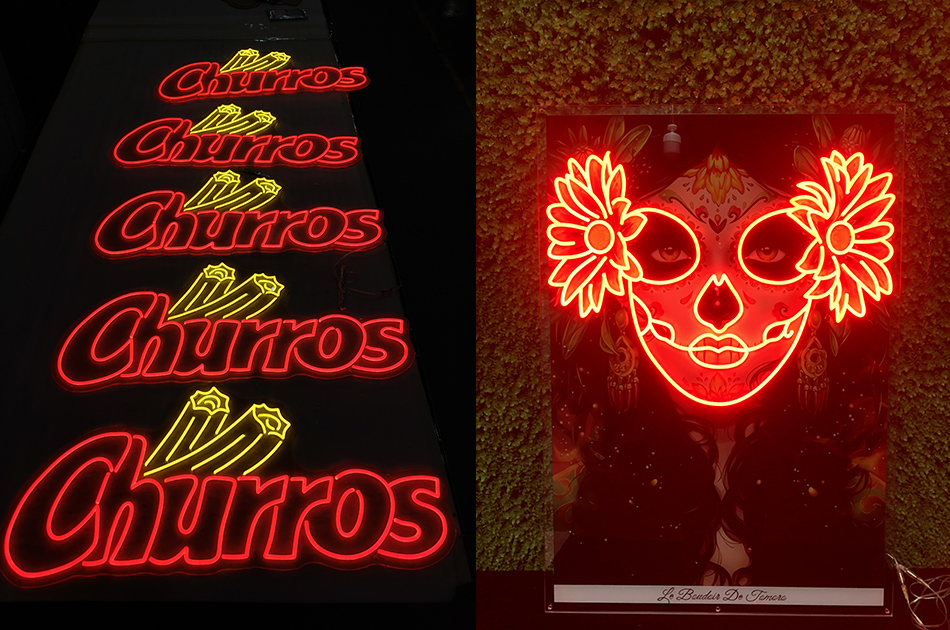
Installation and Maintenance: Preserving Retro Charm
Professional Installation for Authenticity
Structural Planning: Glass neon signs require reinforced mounting (e.g., steel brackets) to prevent vibration damage, especially in busy diners. LED neon flex, lighter and more flexible, adapts to curved surfaces (e.g., rounded doorways) with minimal hardware.
Electrical Safety: Glass neon’s high-voltage systems demand certified electricians to install transformers and ground wiring, ensuring compliance with restaurant safety codes. LED neon’s low-voltage design simplifies installation, though waterproofing is critical for kitchen areas.
Lighting Integration: Pairing neon with complementary lighting—warm incandescent bulbs, retro gooseneck fixtures—enhances the vintage ambiance without overwhelming the neon’s glow.
Maintenance Best Practices
Glass Neon Care:
Monthly Inspections: Check for loose tubes, dim spots (indicating gas loss), or cracked glass. Professional re-gassing or tube replacement should be scheduled annually.
Gentle Cleaning: Dust with a soft brush; avoid water or chemicals that can damage glass or electrodes.
LED Neon Flex Maintenance:
Quarterly Checks: Inspect for loose connections, dim LEDs, or damaged silicone casings. Replace individual LED segments as needed to maintain uniform glow.
Simple Cleaning: Wipe with a damp microfiber cloth to remove food splatters or grease, common in diner environments.
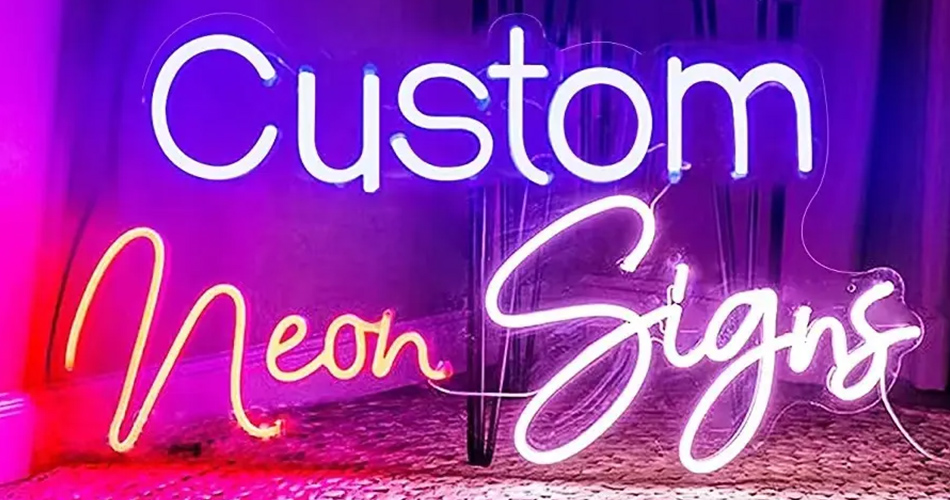
Trends in Retro Neon Diner Design
Hybrid Nostalgia: Blending Eras
70s Retro Fusion: Diners combining 50s neon with 70s earth tones (avocado green, harvest gold) for a multi-decade retro vibe, using neon to tie disparate elements together.
Pop Culture Crossovers: Neon signs featuring retro movie quotes (“GREASE IS THE WORD”) or classic diner scenes from films, appealing to nostalgic millennials and Gen Z.
Sustainable Retro
Vintage Repurposing: Restoring original 1950s neon signs (sourced from closed diners) with modern LED components, preserving historical character while improving efficiency.
Eco-Friendly Materials: LED neon flex made from recycled silicone, paired with reclaimed wood or metal backings, aligning retro aesthetics with modern sustainability goals.
Interactive Retro Experiences
Photo-Worthy Installations: Oversized neon “DINER” signs or retro phrases (“EAT HERE”) designed as backdrop for social media, driving organic marketing. Some restaurants add props (vintage jackets, jukebox replicas) to enhance shareability.
Customizable Elements: Diners offering personalized neon nameplates for regulars (e.g., “REGULAR’S CORNER”) in retro fonts, fostering community and loyalty.
Overcoming Common Challenges
Challenge 1: Balancing Nostalgia with Modern Functionality
Solution: Use LED neon for high-traffic or wet areas (kitchens, bars) while reserving glass neon for focal points (entryways, dining rooms), blending authenticity with practicality.
Challenge 2: Avoiding Kitschy Overkill
Solution: Limit neon to 2–3 key areas per space, pairing it with subtle retro elements (checkerboard floors, vintage menus) to create cohesion without cluttering the design.
Challenge 3: Budget Constraints for Glass Neon
Solution: Prioritize glass neon for exterior signs (first impressions) and use LED neon flex for interior accents, balancing cost with visual impact.
Conclusion: Retro Neon as a Timeless Dining Asset
Retro neon diner signs are more than decor—they are cultural touchstones that transform restaurants into destinations. By blending mid-century design principles with modern materials, these signs create spaces that feel both familiar and fresh, appealing to nostalgia seekers and casual diners alike. Whether through the authentic flicker of glass neon or the durable glow of LED retro flex, they reinforce brand identity, encourage social engagement, and turn meals into memorable experiences.
In an industry where differentiation is key, retro neon diner signs offer a proven path to creating spaces that stand out—warm, welcoming, and steeped in the timeless charm of diners past, yet perfectly suited for the demands of modern dining. For restaurateurs aiming to serve not just food, but nostalgia, these signs are an indispensable ingredient.